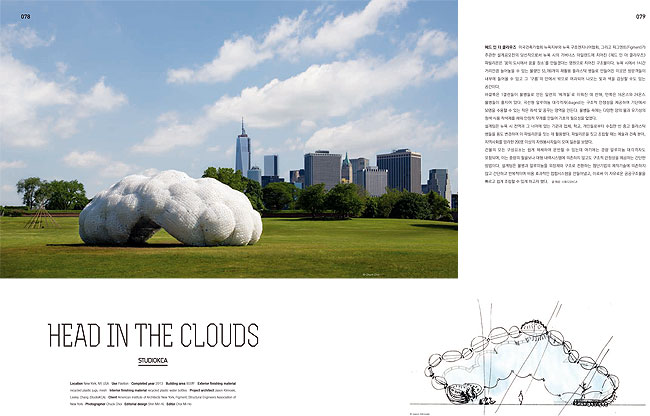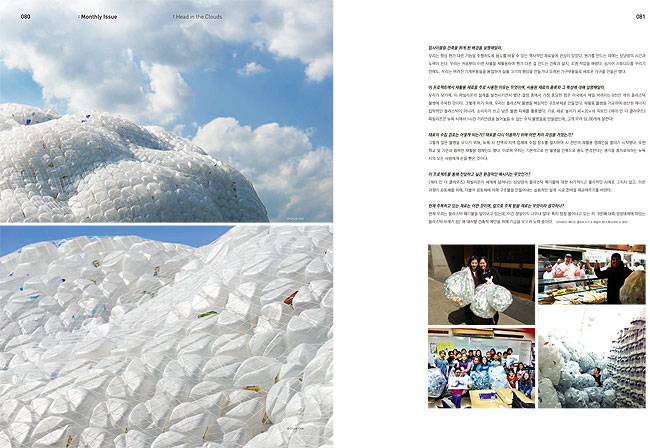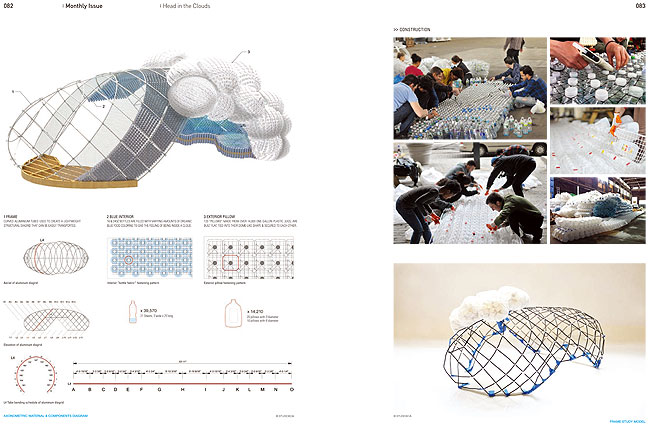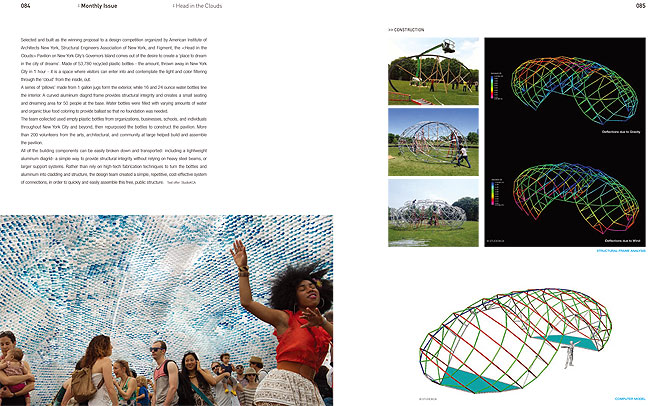Head in the Clouds
StudioKCA




헤드 인 더 클라우즈 미국건축가협회 뉴욕지부와 뉴욕 구조엔지니어협회, 그리고 피그멘트(Figment)가 주관한 설계공모전의 당선작으로서 뉴욕 시의 거버너스 아일랜드에 지어진 <헤드 인 더 클라우즈> 파빌리온은‘ 꿈의 도시에서 꿈꿀 장소’를 만들겠다는 염원으로 지어진 구조물이다. 뉴욕 시에서 1시간 거리만큼 늘어놓을 수 있는 물량인 53,780개의 재활용 플라스틱 병들로 만들어진 이곳은 방문객들이 내부에 들어올 수 있고 그‘ 구름’의 안에서 밖으로 여과되어 나오는 빛과 색을 감상할 수도 있는 공간이다.
바깥쪽은 1갤런들이 물병들로 만든 일련의 ‘베개들’로 이뤄진 데 반해, 안쪽은 16온스와 24온스 물병들이 줄지어 있다. 곡선형 알루미늄 대각격자(diagrid)는 구조적 안정성을 제공하며 기단에서 50명을 수용할 수 있는 작은 좌석 및 꿈꾸는 영역을 만든다. 물병들 속에는 다양한 양의 물과 유기성의 청색 식품 착색제를 채워 안정적 무게를 만들어 기초의 필요성을 없앴다.
설계팀은 뉴욕 시 전역과 그 너머에 있는 기관과 업체, 학교, 개인들로부터 수집한 빈 중고 플라스틱 병들을 용도 변경하여 이 파빌리온을 짓는 데 활용했다. 파빌리온을 짓고 조립할 때는 예술과 건축 분야, 지역사회를 망라한 200명 이상의 자원봉사자들이 모여 일손을 보탰다. 건물의 모든 구성요소는 쉽게 해체하여 운반할 수 있는데 여기에는 경량 알루미늄 대각격자도 포함되며, 이는 중량의 철골보나 대형 내력시스템에 의존하지 않고도 구조적 안정성을 제공하는 간단한 방법이다. 설계팀은 물병과 알루미늄을 외장재와 구조로 전환하는 첨단기법의 제작기술에 의존하지 않고 간단하고 반복적이며 비용 효과적인 접합시스템을 만들어냈고, 이로써 이 자유로운 공공구조물을 빠르고 쉽게 조립할 수 있게 하고자 했다.
글 제공: 스튜디오KCA
업사이클링 건축을 하게 된 배경을 설명해달라.
우리는 항상 뭔가 다른 기능을 수행하도록 용도를 바꿀 수 있는 역사적인 재료들에 관심이 있었다. 뭔가를 만드는 데에는 상당량의 시간과 노력이 든다. 우리는 처음부터 이런 사물을 재활용하여 뭔가 다른 걸 만드는 건축과 설치, 조명 작업을 해왔다. 심지어 스튜디오를 꾸리기 전에도, 우리는 버려진 기계부품들을 용접하여 실물 크기의 형상을 만들거나 오래된 가구부품들로 새로운 가구를 만들곤 했다.
이 프로젝트에서 재활용 재료을 주로 사용한 이유는 무엇이며, 사용된 재료의 종류와 그 특성에 대해 설명해달라.
우리가 보기에, 이 파빌리온의 설계를 발전시키면서 했던 결정 중에서 가장 중요한 점은 미국에서 매일 버려지는 6천만 개의 플라스틱 물병에 주목한 것이다. 그렇게 하기 위해, 우리는 플라스틱 물병을 핵심적인 구조부재로 만들었다. 재활용 물병을 가공하여 생산된 에너지 집약적인 플라스틱이 아니라, 소비자가 쓰고 남은 물병 자체를 활용했다. 가로,세로,높이가 40ⅹ20ⅹ18 피트인 <헤더 인 더 클라우즈> 파빌리온은 뉴욕 시에서 1시간 거리만큼을 늘어놓을 수 있는 수의 물병들로 만들었는데, 그게 무려 53,780개에 달한다!
재료의 수집 경로는 어떻게 되는가? 재료를 다시 이용하기 위해 어떤 처리 과정을 거쳤는가?
그렇게 많은 물병을 모으기 위해, 뉴욕 시 전역의 지역 업체에 수집 장소를 설치하여 시 전반의 재활용 캠페인을 벌이기 시작했다. 또한 학교 및 기관과 협력한 재활용 캠페인도 했다. 이로써 우리는 기본적으로 빈 물병을 건축으로 용도 변경한다는 생각을 흥미로워하는 뉴욕 시의 모든 사람에게 손을 뻗은 것이다.
이 프로젝트를 통해 전달하고 싶은 환경적인 메시지는 무엇인가?
<헤더 인 더 클라우즈> 파빌리온이 세계에 넘쳐나는 상당량의 플라스틱 폐기물에 대한 시각적이고 물리적인 사례로 그치지 않고, 이런 과정이 공동체를 위해, 더불어 공동체에 의해 구조물을 만들어내는 실용적인 설계,시공 전략을 제공해주기를 바란다.
현재 주목하고 있는 재료는 어떤 것이며, 앞으로 주목 받을 재료는 무엇이라 생각하나?
현재 우리는 플라스틱 폐기물을 알아보고 있는데, 이건 정말이지 너무나 많다! 특히 점점 불어나고 있는 저‘ 8번째 대륙(망망대해에 떠있는 플라스틱 쓰레기 섬)’에 대처할 건축적 제안을 위해 기금을 모으려 노력 중이다.
인터뷰이: 제이슨 클리모스키 & 레슬리 창(스튜디오KCA 대표)
Selected and built as the winning proposal to a design competition organized by American Institute of Architects New York, Structural Engineers Association of New York, and Figment, the [Head in the Clouds] Pavilion on New York City’s Governors Island comes out of the desire to create a ‘place to dream in the city of dreams’.
Made of 53,780 recycled plastic bottles - the amount, thrown away in New York City in 1 hour - it is a space where visitors can enter into and contemplate the light and color filtering through the ‘cloud’ from the inside, out. A series of ‘pillows’ made from 1 gallon jugs form the exterior, while 16 and 24 ounce water bottles line the interior.
A curved aluminum diagrid frame provides structural integrity and creates a small seating and dreaming area for 50 people at the base. Water bottles were filled with varying amounts of water and organic blue food coloring to provide ballast so that no foundation was needed. The team collected used empty plastic bottles from organizations, businesses, schools, and individuals throughout New York City and beyond, then repurposed the bottles to construct the pavilion. More than 200 volunteers from the arts, architectural, and community at large helped build and assemble the pavilion.
All of the building components can be easily broken down and transported- including a lightweight aluminum diagrid- a simple way to provide structural integrity without relying on heavy steel beams, or larger support systems. Rather than rely on high-tech fabrication techniques to turn the bottles and aluminum into cladding and structure, the design team created a simple, repetitive, cost-effective system of connections, in order to quickly and easily assemble this free, public structure.
Text offer: StudioKCA
Please explain in what background you’ve come to make upcycling architecture. We have always been interested in materials with a history that could be re-purposed to serve some other function. There is an incredible amount of time and effort spent in making things, to reuse these objects to make something else has informed our architecture, installations, and lights, since we started. Even before we formed our studio, we were welding life-sized figures from scrap machine components, and creating new furniture from old furniture components.
Is there any particular reason for using Recycled materials as main material for this project? And what types of materials have you used in this project, and what general properties do they have?
For us, one of the most important decisions in developing the design of the pavilion was to call attention to the 60 million plastic bottles thrown away every day in the United States. To do so, we made the plastic bottle our key building block in the construction. We used the postconsumer bottle itself, not the energy-intensive plastic produced from processing recycled bottles. At 40x20x18 feet, the [Head in the Clouds] Pavilion is made of the number of bottles thrown away in just one hour in New York City- that’s 53,780 bottles!
In what ways have you acquired the materials? What processes were required for reusing them? Tell me about them in more detail.
To collect that many bottles, we launched a city-wide recycling campaign where we set up collection stations in local businesses all over New York. We also partnered with schools and organizations to create recycling campaigns. We basically reached out to anyone and everyone in New York City excited by the prospect of repurposing their empties into architecture.
What environmental message do you want to communicate through this project?
We hope that the [Head in the Clouds] Pavilion not only provides a visual and physical example of the vast amount of plastic waste in the world, we hope the process provides a viable design and construction strategy to create structures for and by communities.
What material are you looking at now? And do you think what material will get much attention in the future?
We are still looking at plastic waste- there is so much of it! Specifically, we are working to get funding for an architectural proposal to address the growing “8th continent” (plastic waste island floating in the ocean).
Interviewee: Jason Klimoski & Lesley Chang, principals, STUDIOKCA
건축문화 2016년 8월호 [Monthly Issue]페이지 © 에이엔씨출판(주)